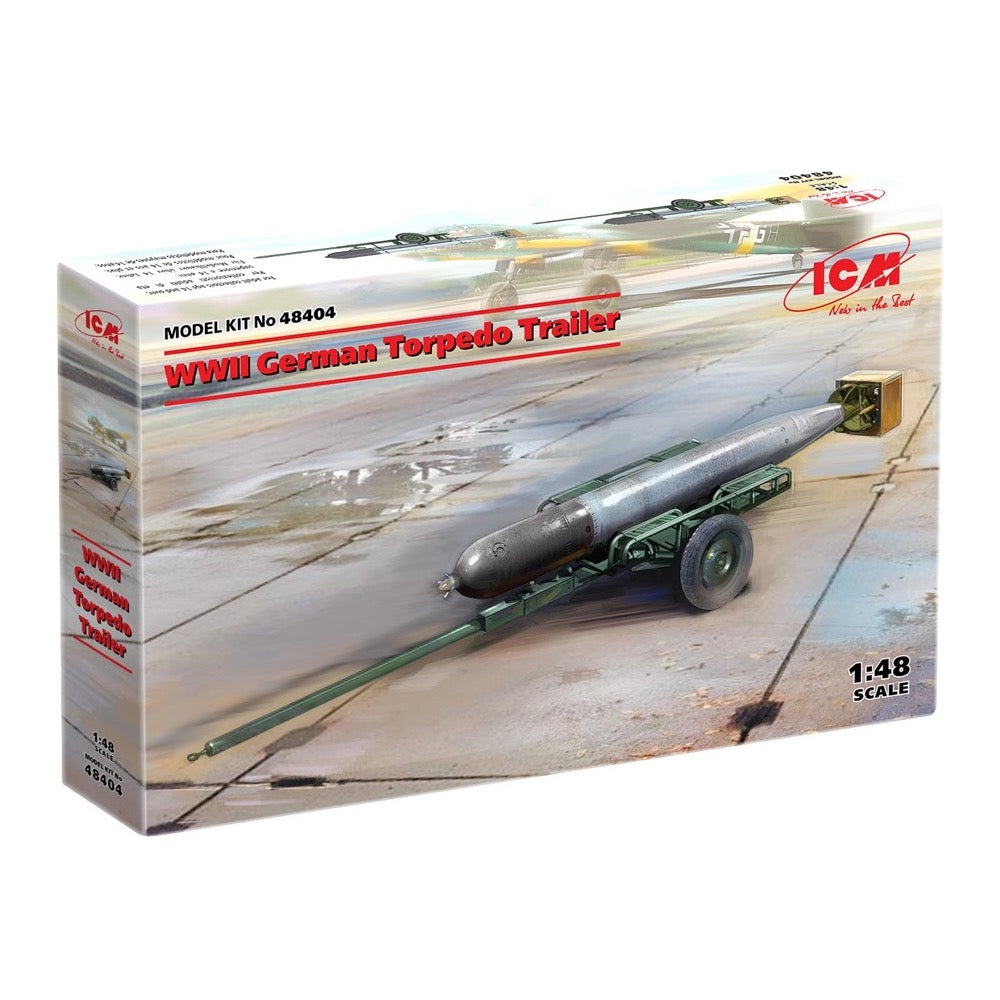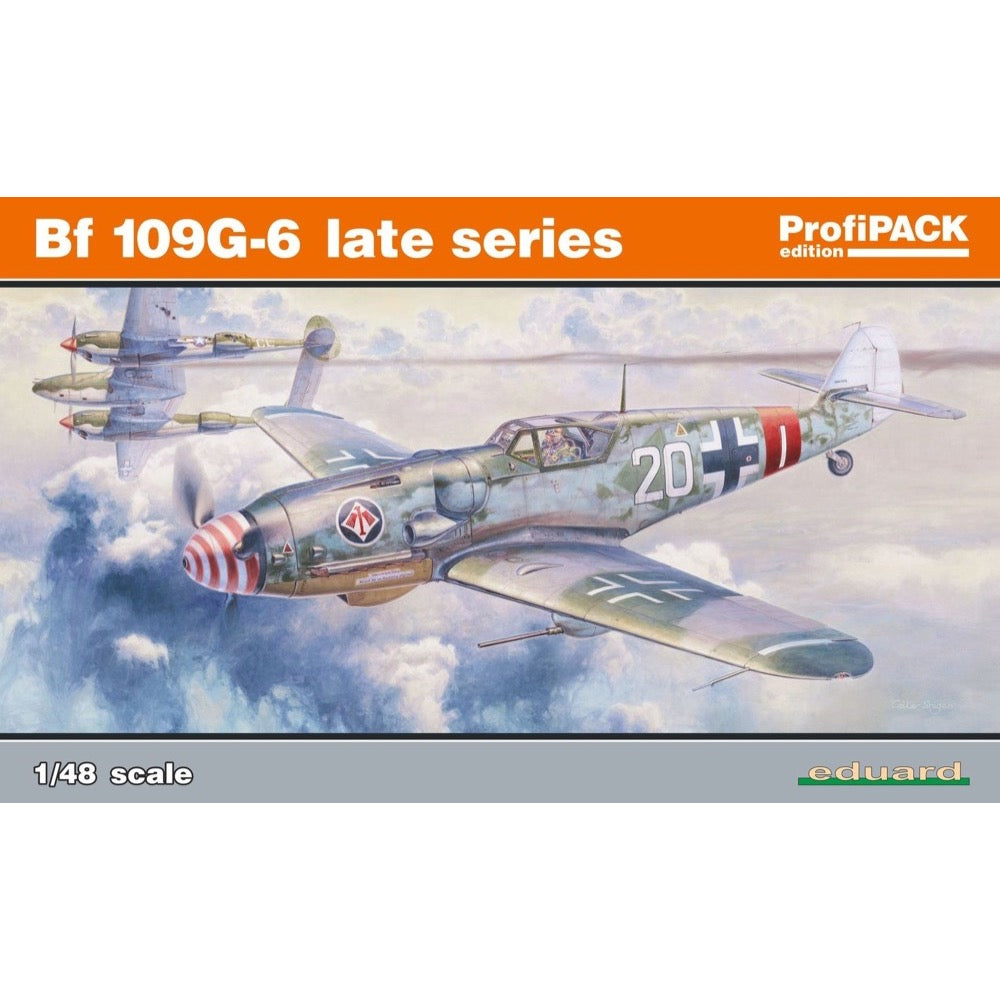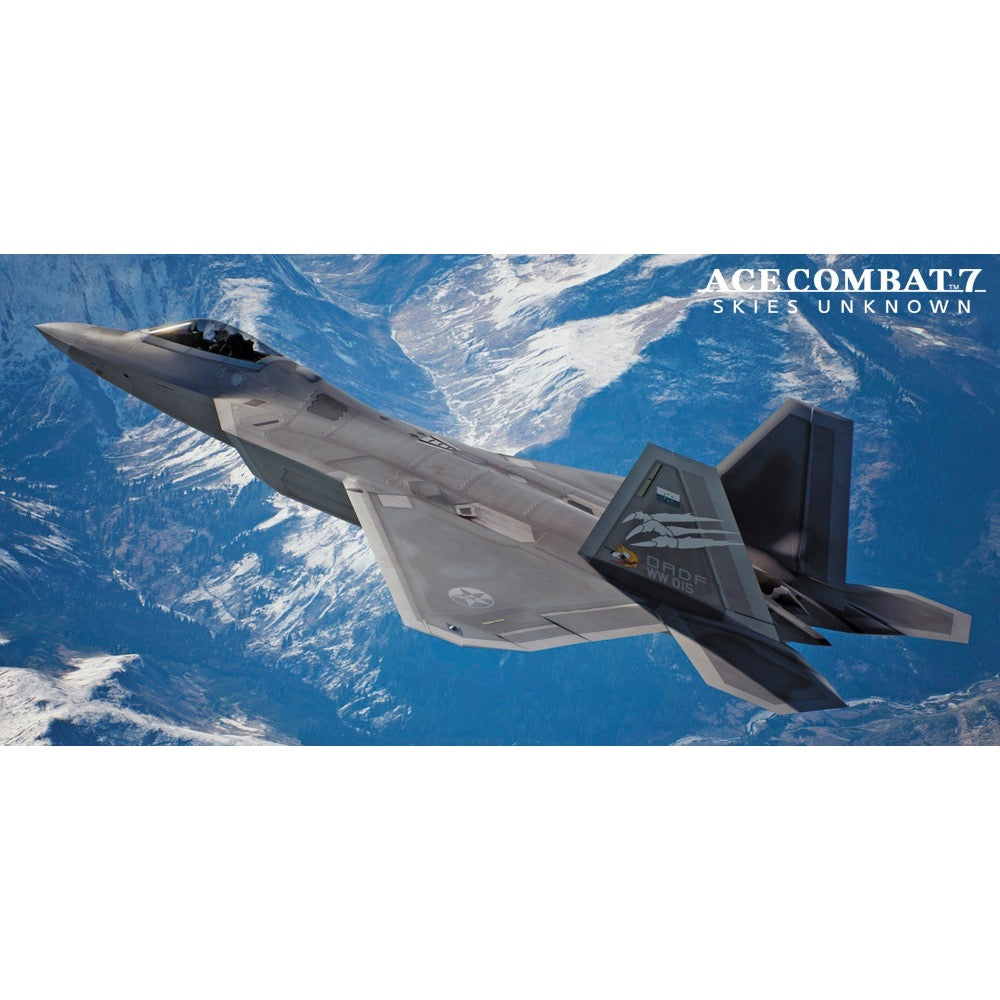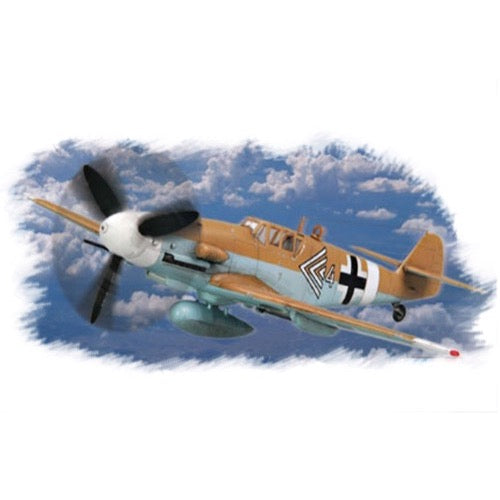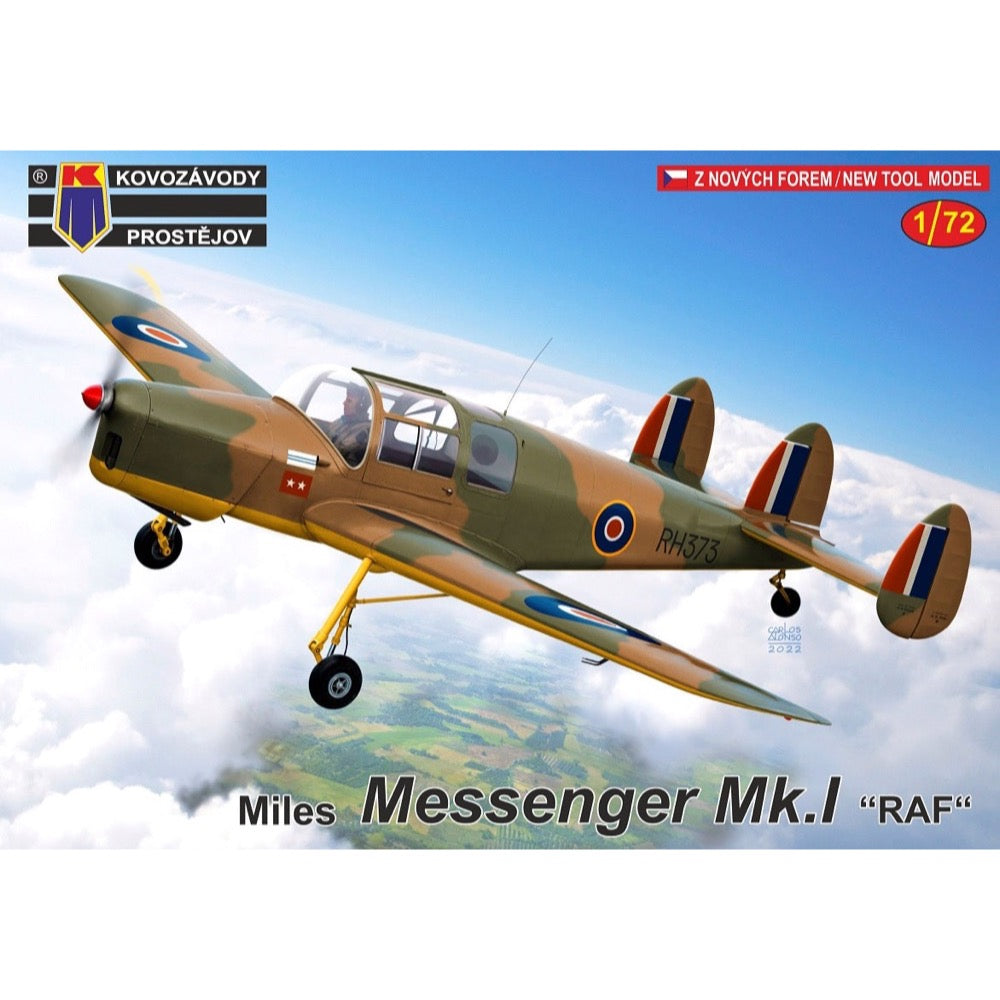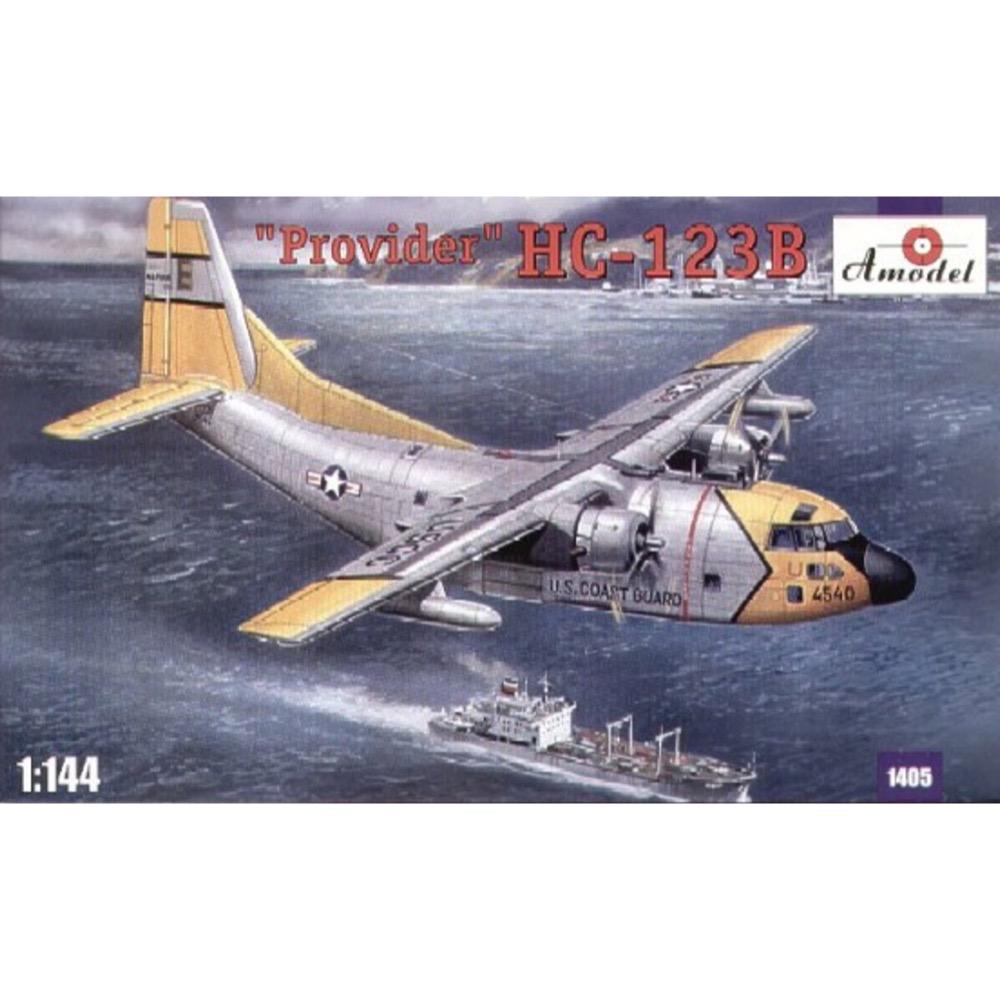
Special Hobby 48202 1/48 AH-1G Cobra Spanish & IDF/AF Cobras
30.00
$
<h3>AH-1G Cobra ‘Spanish & IDF/AF Cobras’ 1/48</h3>
<p>The AH-1G Cobra was the very first helicopter primarily developed for anti ground missions. AH-1G Cobras saw their combat premiere in Vietnam in 1967. The early machines can be recognized by the tail with port-side mounted tail rotor, later ones had the usual configuration of the tail rotor on the starboard side. The AH-1G became the first member of a really wide family of ground attack helicopters which keep on serving until these days. The G version fought in the Vietnam war, saw service in the skies of the USA, Westen Europe and was also succesfully exported abroad – the G models could be seen flying both in Spain and Israel.</p>
<p>And this is what you will find in our first boxing of the quarter scale Cobra kit – superbly detailed kit coming on as many as ten styrene sprues joined by one of clear parts, plus colour options for two machines of the Spanish Navy in fancy dark blue guise and another two, though in drab olive, which can boast themselves by taking part in introducing the idea of armed combat helicopters to the Israeli air force. Let us also mention that all these four airframes were fitted with the Vulcan cannon-based M35 weapon system carried along the sides of the fuselage (ammunition boxes) and under the port-side stub wing (the cannon itself)</p>
<h3>Features</h3>
<ul>
<li>The model of the historicaly very first combat helicopter</li>
<li>Top-notch quarter scale AH-1G model kit made to the current standards. Any other model in this scale is hugely outdated.</li>
<li>Decal sheet with a full set of stencils and markings for four machines</li>
</ul>
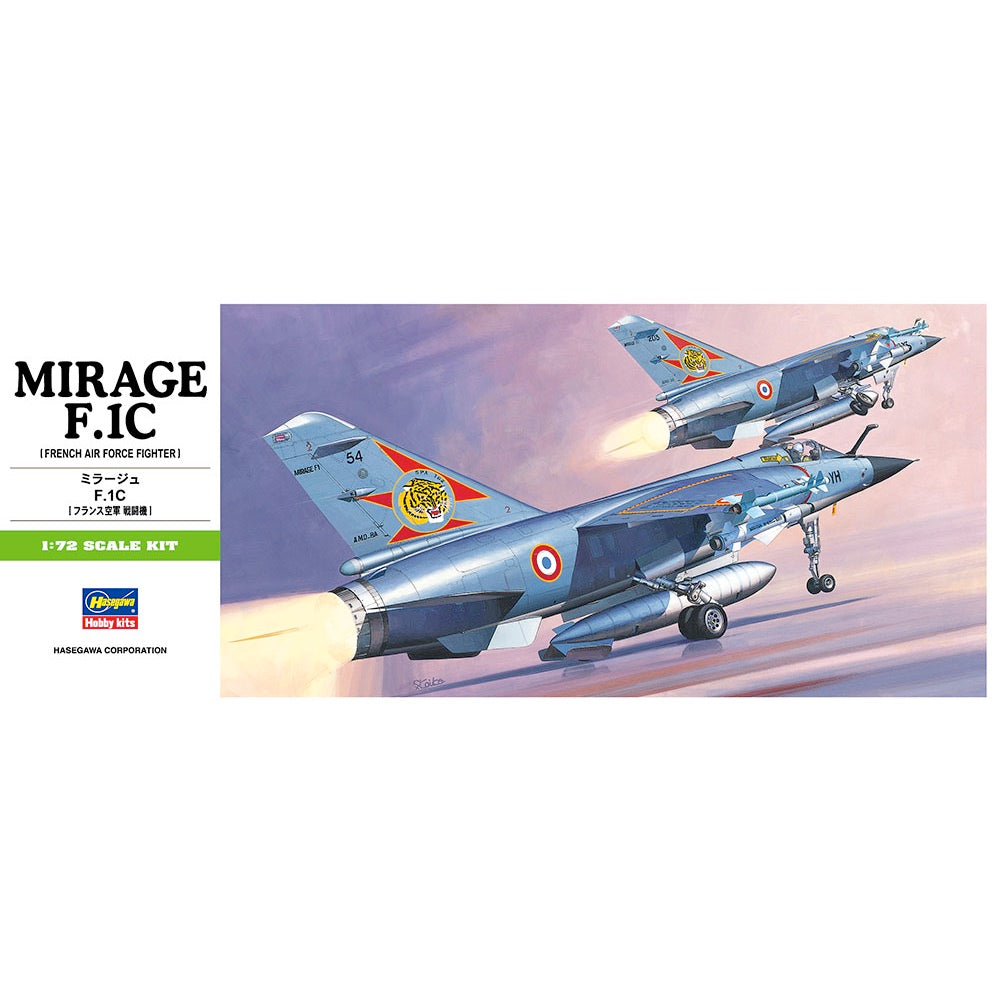
Hasegawa 00234 1/72 Mirage F.1C
6.00
$
<h3>The Dassault-Breguet Mirage F.1C is an all-weather interceptor fighter of the French Air Force.</h3>
<p>The main wings have been changed from the delta wing characteristic of the Mirage to a normal high-wing configuration, improving takeoff and landing performance. The fire control system is also equipped with a more powerful Cyrano IV type, which is effective not only for high-altitude interception but also for ground attacks. In addition to the C type, the Mirage F.1 series also includes the A, B, R, and E types.</p>
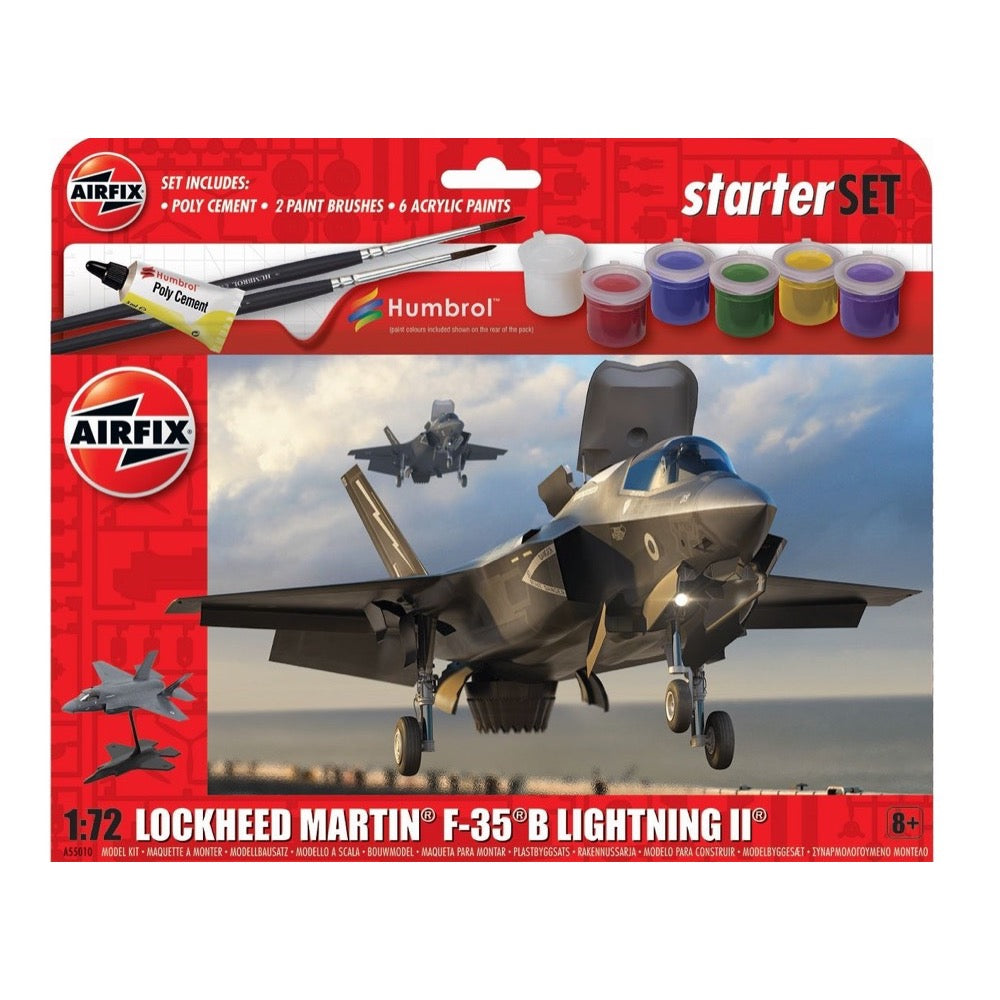
Airfix 55010 1/72 Lockheed Martin F-35B Lightning II Starter Set
16.00
$
<h3>Lockheed Martin® F-35B® Lightning II®</h3>
<div>
<p>Designed to dominate the skies, the Lockheed Martin® F-35B® is the most advanced multi-combat aircraft in the world. Using stealth technologies to operate undetected in hostile airspace or relaying vital battlefield information to other friendly forces. The new jet is the third aircraft in RAF service to carry the Lightning name, however, it did not carry over when it entered British service.</p>
</div>
<ul>
<li>Designed for Beginners</li>
<li>6 x Acrylic Paints</li>
<li>1 x Poly-Cement</li>
<li>2 x Brush</li>
<li>1 x Shadow Stand</li>
</ul>
<p>As one of the most advanced aircraft in the world, the Lockheed Martin® F-35B® Lightning® is a fifth generation multi-role combat aircraft designed to dominate the skies, using stealth technologies to operate undetected in hostile airspace, striking at the heart of the enemy, or relaying vital battlefield information to other friendly forces. </p>
<p>The United Kingdom has elected to take the short take-off and vertical landing (STOVL) 'B' variant of the F-35, allowing their aircraft to operate from traditional airfields, from the decks of Britain’s two new Queen Elizabeth class aircraft carriers and should the need arise, from dispersed locations, in much the same way as the famous Harrier previously did. </p>
<p>In British service, the F-35 will not carry the Lightning II denotation, as the new jet is actually the third aircraft in RAF service to carry the name, after the Lockheed P-38 from the Second World War and the famous English Electric Lightning which served throughout the Cold War era.</p>
<h4>Contains</h4>
<ul>
<li>Plastic model kit</li>
<li>Instruction sheet</li>
<li>Paint layout sheet</li>
<li>Decals.</li>
</ul>
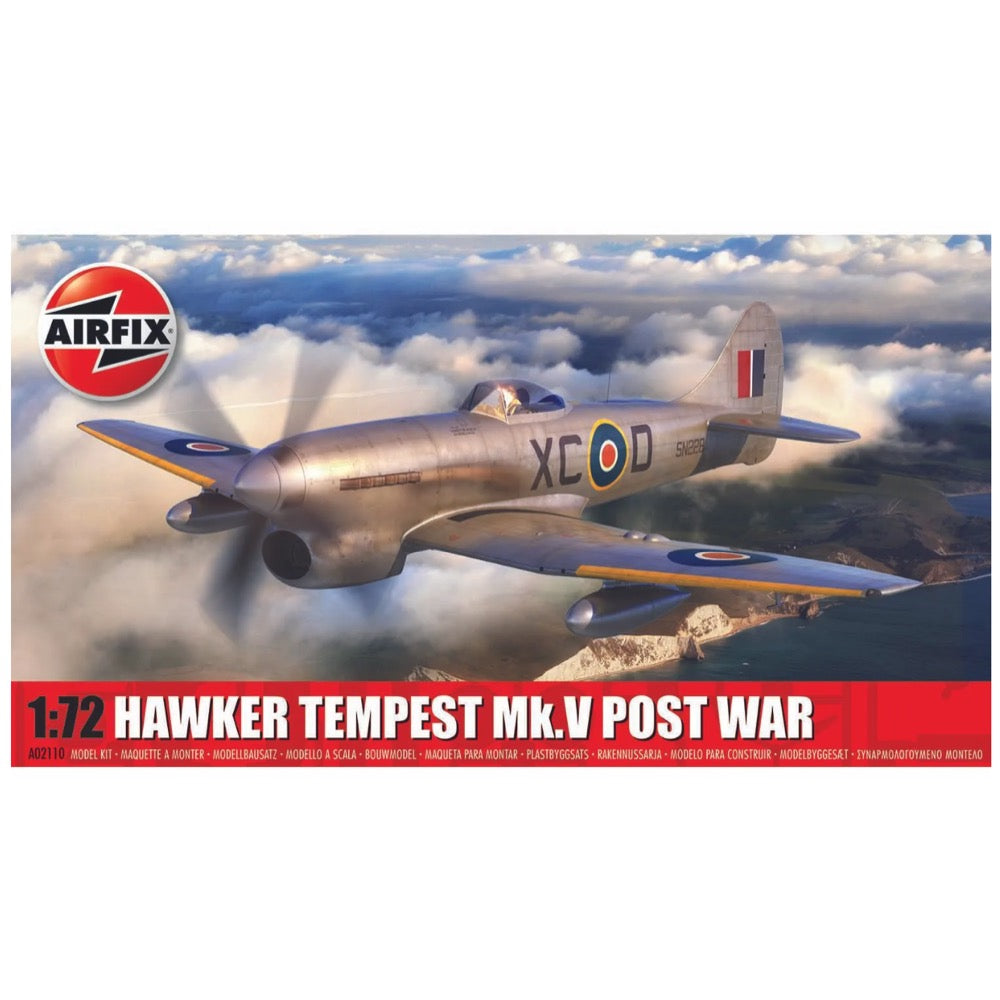
Airfix 02110 1/72 Hawker Tempest Mk.V Post War
10.00
$
<p>Featuring a newly designed laminar flow wing and a much thinner compared to its predecessor, this plane had its first flight on 2nd September 1942. With its lighter frame and powered by a massive 24-cylinder Napier sabre engine, this fighter aircraft performance was spectacular.</p><p>An aircraft which has to be considered one of the finest aeroplanes of the Second World War, the Hawker Tempest V could trace its design lineage back to the Hurricane fighters which proved so decisive during the Battle of Britain only two years earlier, but would represent the absolute zenith of piston engined fighter design. Indeed, when accomplished designer Sydney Camm was looking to produce his '˜Super Hurricane'™ replacement for the aviation saviour of the Battle of Britain, the aircraft he surely had in mind was the Tempest V. As it was, the Tempest is often confused with its predecessor in Royal Air Force service, the Typhoon, even though the two are very different aeroplanes.</p><p>The original fighter replacement for the Hawker Hurricane was the Typhoon, an aircraft which attempted to combine the most powerful piston engine available at the time with a small, yet strong and heavily armed airframe. Although intended as an interceptor fighter, it became apparent during development that the new aircraft would not be able to fulfil this role, as the thickness of the wing was not conducive to high performance at high altitude. In fact, the Typhoon would endure quite a troubled development and service introduction, to the point where cancellation of the programme was seriously considered at one time. Nevertheless, the Typhoon would eventually go on to find its aviation niche as a hard-hitting ground attack aircraft and one which would come into its own during the time of the Allied invasion of Normandy.</p><p>Aware that their Typhoon had great potential but was in need of improvement, the Hawker design team started work on a new fighter project, one which incorporated many of the same philosophies as Typhoon, but also, several significant modifications. Indeed, the new aircraft was initially referred to as the Typhoon Mark II, but this was changed to Tempest as the prototype aircraft'™s first flight approached. Although this was still a big aeroplane for a single engined fighter, its airframe was light and it would be powered by the massively powerful 24 cylinder Napier Sabreengine, a powerplant which would give the new fighter spectacular performance. Making its first flight on 2nd September 1942, the new Hawker Tempest featured a newly designed laminar flow wing, which was much thinner than the wing used on its predecessor and allowed the new fighter to slip through the air at incredible speed.</p><p>At first glance, the Typhoon and Tempest do share many similarities, however, if you know where to look, it is not difficult to tell them apart. Without doubt, the wing is the most obvious distinguishing feature, as not only is this thinner than the one used on the Typhoon, it is also a completely different shape. With a straighter leading edge and more elliptical trailing edge, the Tempest'™s wing was designed for speed, even though it could still be used effectively in a ground attack role. Other Tempest design differences include a slightly longer nose and a tail section which appears to be much larger, with a more generous vertical stabiliser which features a pronounced dorsal fillet. During the prototype aircraft'™s maiden flight, it posted an impressive top speed of 477 mph in level flight, impressing both the design team and the watching Air Ministry.</p><p>The Hawker Tempest V entered Royal Air Force service in early 1944, with the first two squadrons to receive the type having both previously operated the Typhoon. It was thought that managing the incredible power generated by the Tempest'™s engine could pose problems for pilots converting from smaller aircraft types and that former Typhoon units would be best placed to negotiate its squadron introduction. In advance of the D-day landings, Tempests were being used in a similar ground attack role to the one being flown so effectively by Typhoon squadrons, however, should it be required to make the shift to air combat operations mid-mission, the Tempest was much more suited to this task. Possessing significantly greater range than the Typhoon, Tempests could loiter in the combat zone for longer periods, allowing offensive strikes deeper into occupied Europe, or allowing pilots to wait patiently for the Luftwaffe to come up and fight, where they could show them what their new fighter could really do.</p><p>As the fastest Allied fighter at low and medium altitudes, Tempest squadrons were held back for home defence duties in the weeks which followed the successful D-day landings, due to the onslaught of a sinister new weapon, the V-1 '˜Doodlebug'™ pulse jet flying bomb. The Tempest proved to be an excellent V-1 killer, using the speed of the fighter, effectiveness of its guns and bravery of its pilots to destroy large numbers of these terrifying weapons before they could wreak their havoc on British towns and cities. Britain'™s most effective force against these indiscriminate weapons, hundreds of Doodlebugs were shot down by the RAF'™s Hawker Tempest V squadrons, with Squadron Leader Joseph Berry proving to be the most proficient at this work, with no fewer than 61 V-1 '˜kills'™ to his name.</p><p>With the V-1 threat diminishing, the RAF'™s Tempest V squadrons were free to embark on aggressive seek and destroy missions into occupied Europe, using the speed, range and firepower of their latest fighter to great effect. Looking for potential V-1 launch sites and increasingly, the new German jet fighters which had started operating against the Allied air forces, the Tempest began to show that it was undoubtedly one of the most capable fighting aeroplanes in the world. Indeed, it has been reported that the aggressively flown Tempest was the Allied aircraft Messerschmitt Me262 jet pilots most feared during those early days of jet powered operations, particularly if they were caught during the landing and taking off phases of flight, when their jets were much more vulnerable.</p><p>There is no doubt that the Hawker Tempest V was a real brute of an aeroplane, fast, heavily armed and possessing performance which could better any fighter the Luftwaffe had in service, perhaps with the exception of the Me262 at full speed. Pilots who had experience flying both the Tempest V and its predecessor, the Typhoon, describe the difference as being like night and day - they actually said that it was like comparing a cart horse with a race horse. Although this seems a little harsh, as they flew the aircraft in combat, we should certainly bow to their judgement. Although appearing relatively late in WWII, the Tempest V still takes its place as one of the most effective piston engined fighters of the Second World War and was perhaps the '˜Super Hurricane'™ designer Sydney Camm had always envisaged developing.</p><h3>Specifications</h3><ul>
<li>Item Length - Without Packaging (cm): 14.3</li>
<li>Item Width - Without Packaging (cm): 17.4</li>
<li>How many pieces will be found in the box opened by the customer?: 72</li>
<li>Item Scale: 1:72</li>
<li>License line: BAE SYSTEMS is a registered trade mark of BAE Systems plc.</li>
<li>Contents (what's in the box) sets: Plastic model kit, instruction sheet, paint layout sheet and decals.</li>
<li>Finish: Plastic</li>
<li>Number of Scheme options: 2</li>
<li>Skill Level: 2</li>
<li>Flying Hours: 1</li>
<li>Wingspan (mm): 174</li>
</ul>

Airfix A17001 1/24 Supermarine Spitfire Mk.IXc
71.00
$
<h3>Supermarine Spitfire Mk.IXc</h3>
<p>Earning its legendary reputation during the Battle of Britain, the Supermarine Spitfire holds an iconic status after serving as a beacon of hope for the nation during their darkest hour. The striking appearance offers elegance, masking the true form of this deadly fighting aeroplane.</p>
<ul>
<li>1:24 Scale</li>
<li>Includes Early and Late Intakes</li>
<li>Wingspan: 469 (mm)</li>
<li>Breech Blisters</li>
<li>Plus Clipped Wings</li>
</ul>
<p>In the world of aviation, is there any aircraft which can even come close to matching the iconic status the Supermarine Spitfire enjoys, a legacy which is as strong today as it was during the wartime years? A modern monoplane fighter aircraft which made its first flight from Eastleigh Aerodrome on 5th March 1936, the Spitfire would earn its legendary reputation during the Battle of Britain, when the pilots of the Royal Air Force stood defiantly against the overwhelming might of the all-conquering Luftwaffe, an aviation beacon of hope for a nation and its people during their darkest hour. </p>
<p>Elegant and graceful to look at, the Spitfire's appearance masked the fact that this was a deadly fighting aeroplane and one which was adaptable enough to undergo almost constant development throughout the wartime years, allowing later marks of the fighter to post speeds which were almost 100 mph faster than the first machines to enter service. With a service career which extended well into the post war years, the Spitfire outlived all its aviation contemporaries and with over 22,000 Spitfires of all variants (including Seafires) eventually being built, Spitfires are still a regular sight at Airshow events all over the world, as an ever increasing number of restored airworthy aircraft continue to write the enduring Spitfire story. Even though the prototype Spitfire made its first flight over 85 years ago, the aircraft is still widely regarded as Britain's most famous aircraft type and instantly recognisable to many millions of people the world over.</p>
<p>The Spitfire Mk.IX variant was arguably the most important mark of Spitfire in the entire production run and because of that, it is somewhat surprising to learn that it was actually something of a stop-gap development. The arrival of the Luftwaffe's new Focke Wulf 190 fighter over the Western Front in August 1941 saw RAF Spitfire Mk.Vs operating over the Channel falling victim to the 'Butcher Bird' in ever increasing numbers and something had to be done. A major Spitfire upgrade was in progress, but the Mk.VIII was still some way off, as manufacturing facilities prepared their tooling jigs for the new aircraft, but there was a temporary solution. One of the major features of the new Spitfire was its use of a powerful new version of the Rolls Royce Merlin engine and it was proposed that fitting this new engine to a Spitfire Mk.V airframe would give the fighter a welcome performance boost.</p>
<p>The first 100 Spitfire Mk.IX fighters were actually Mk.Vc airframes adapted to take the new Merlin 61 two stage, two speed supercharged engine, with this combination producing a thoroughbred fighting aeroplane, one which was more than capable of challenging the FW190 and the latest 'F' variant of the Messerschmitt Bf 109. In fact, the new Spitfire was considered so successful that this would become the second most heavily produced variant in the entire production run and if including the aircraft powered by the licence built Packard Merlin 266 (Spitfire Mk.XVI) even eclipsed the Mk.V in production numbers. With further powerplant refinement taking place throughout the production life of this variant, the first Mk.IX Spitfires started to join RAF Squadrons from July 1942, with this famous mark of Spitfire going on to see service past D-Day and into the post war era. The last major Merlin engine powered variant of the Spitfire, this 'emergency stop-gap fighter' actually became something of an aviation classic.</p>
<h4>Includes</h4>
<ul>
<li>Sprues</li>
<li>Decals</li>
</ul>
<h4>Technical Specifications</h4>
<ul>
<li>Item Length - Without Packaging (cm) - 39.7</li>
<li>Item Height - Without Packaging (cm) - 16.08</li>
<li>Item Width - Without Packaging (cm) - 46.9</li>
<li>How many pieces will be found in the box opened by the customer? - 433</li>
<li>Item Scale - 1:24 Scale</li>
<li>Contents (what's in the box) sets - Sprues & decals</li>
<li>Finish - Plastic</li>
<li>Number of Scheme options - 4</li>
<li>Skill Level - 4</li>
<li>Flying Hours - 4</li>
<li>Wingspan (mm) - 469</li>
</ul>
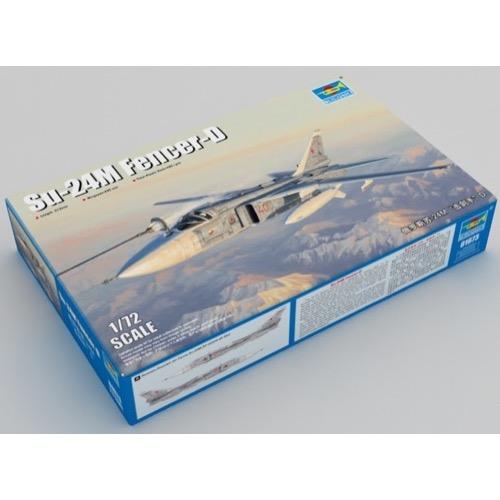
Trumpeter 01673 1/72 Su-24M Fencer-D
32.00
$
<p>High quality, precision plastic model kit. Paint and glue not included. Requires assembly and painting. For intermediate to advanced skill modellers.</p>


